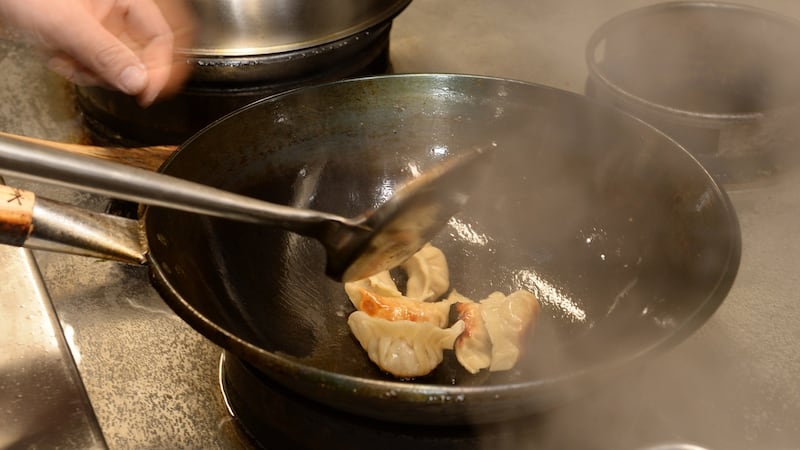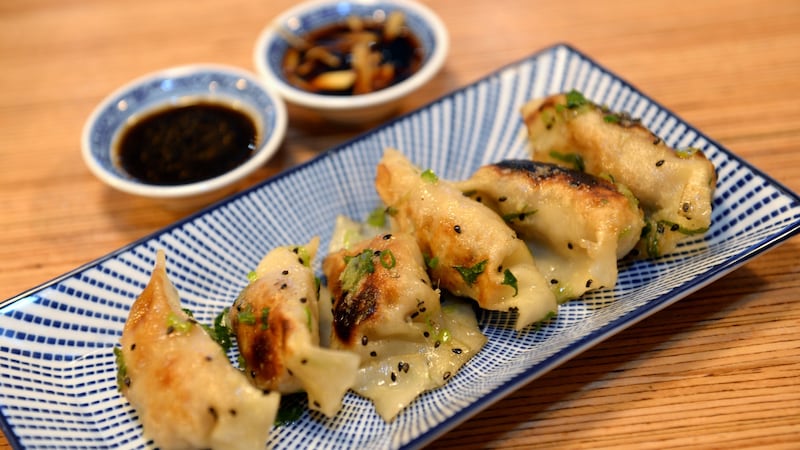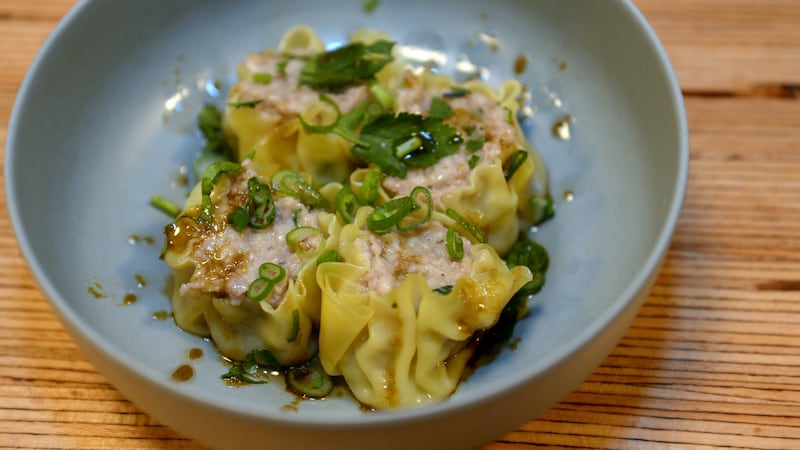Making a neatly pleated Chinese dumpling is a bit like learning to do origami with one hand tied behind your back. It’s not easy.
Millions, if not trillions, of the little pillowy parcels of savoury stuffing encased in thin dough will be consumed in Chinese households at midnight on Monday, as the year of the pig gets under way on February 5th. They are an integral part of the New Year celebrations, signifying wealth and prosperity, due to their shape, which is said to resemble ingots of precious metal. And those tricky pleats are there to ensure that your fortune (the filling) stays intact and safe.
Families gather in Chinese households on New Year’s Eve to make the dumplings together, and each household has its own way of folding and sealing them. Hong Kong-born and Donegal-raised chef Kwanghi Chan says he learned the technique at the hands of his granny, in northern China, and he promises he can teach it to me too.


I’ve been making siu mai, open-topped steamed dumplings, and pot stickers – the part-steamed, part-fried version – for years. Turning out a respectable siu mai is not difficult – a spoonful of filling into a wonton wrapper and a bit of gentle coaxing into a money bag or parcel shape, and you’re good to go.
But when it came to sealing the pot stickers, I was out of my league, resorting to folding the circular wrappers over the filling, and clumsily crimping the edges of the half-moon shape. A quick tap on the counter to give them a flat bottom, and into the pan they went, with the hope that they tasted so good nobody would notice they didn't look at all like the ones in the pages of my well-thumbed Fuchsia Dunlop and Andrea Nguyen books.
But after a hands-on session with Chan at his new Hong Kong street food restaurant, Bowls by Kwanghi, on Marlborough Street in Dublin, I can pleat and pinch like a pro. Well, not quite, but I’m getting better.
“It is like I have passed on my grandmother’s wrapping tradition to you and you’re part of our family now,” Chan says as he holds my first attempt aloft, like a proud parent seeing beauty where others might struggle.

The technique involves wrapping a fold of the wrapper around your index finger, and affixing the pleat securely to the dampened side of the dough, all the while pulling the dumpling into a tight crescent shape. It get easier with practice, I'm sure. But if you can't get the hang of it don't let it stop you making these delicious parcels - as long as they are firmly sealed in any fashion, they will work fine. You'll find lots of video tutorials online.
Although he is best known these days for his Asian cooking, Chan is a classically trained chef, and was head chef at the Cliff House Hotel in Ardmore, Co Waterford. Now, as well as running his restaurant, he has a regular slot on the cookery segment of The 6 O'Clock Show, is a Bord Bia ambassador for Irish beef and lamb in Hong Kong and manufactures and distributes a range of Chinese food products.
During Dublin's Chinese New Year Festival, which runs until February 17th, there will be an opportunity to do a guided tour of the Asia Market oriental supermarket on Drury Street with Chan, followed by a cookery demonstration using produce from the shop. It takes place on Thursday, February 7th, 6pm-7.30pm, and costs €20. Bookings should be made at asiamarket.ie.
Walking around the shop with Chan is a revelation, with all those weird and wonderful vegetables, condiments and dried goods that I’ve always been curious about identified and their various uses explained.
I learned, among other things, that Jan Jan fresh tofu is made in Dublin, that kai lan is one of the tastiest Chinese greens, that I don’t have to wait to visit a favourite Chinese restaurant to enjoy fried turnip cakes, that Pearl River Bridge makes the best soy sauce and that dutiful wives once brought sweet pastries known as “wife cakes” to their hard-working husbands.
The full programme of events for the festival is online at dublinchinesenewyear.com. If your dumpling skills need a bit of polishing, like mine did, you can join a masterclass with M&L Restaurant's resident dumpling queen, Li Xue, who makes about 400 of them every day. It takes place tomorrow, at 2.30pm, and the fee is €25. Places must be booked in advance on 087-7542775.
_______________________________
KWANGHI CHAN RECIPES
Pork and spring onion pot sticker dumplings
Makes 30

Ingredients
160g minced pork (not too lean – some fat is good – about 70:30 ratio)
1tbs fresh ginger, minced (from a half inch knob)
2 scallions, thinly sliced
2 cloves garlic, finely minced (about 2 teaspoons)
1tbs soy sauce
2tsp toasted sesame oil
¾tsp sea salt
Couple of pinches of freshly ground black pepper
30 dumpling or gyoza wrappers (or you can use wonton wrappers and trim them into a circular shape)
60ml vegetable oil
Method
1. Put the minced pork, ginger, scallions and garlic in a bowl and stir to combine. Whisk together soy sauce and sesame oil, then stir into the pork mixture. Stir in the pepper and salt.
2. On a dry surface, lay out one gyoza or dumpling wrapper, keeping the remaining wrappers covered with a dampened cloth or paper towel. Spoon one teaspoon of filling into the centre, then moisten halfway around the edge with a wet finger. Fold the dry half of the wrapper over the wet half to form a half-moon shape.
3. To seal, using thumb and forefinger of one hand, form tiny pleats along the dry edge of the wrapper, pressing the pleats against the moistened border to enclose the filling. The dumpling will curve in a semi-circle. Or, you can start in the middle, pleat out to one edge then turn the dumpling over and pleat in the opposite direction. Stand the dumpling, seam-side up, on a baking sheet and gently press to flatten the bottom. Cover loosely with dampened cloth or paper towel. Form the remaining dumplings in the same way. If you cannot perfect the pleating method, just pinch the edges together to create a seal.
4. Heat the oil in a large, non-stick skillet or frying pan over a moderately high heat, until it is hot but not smoking. Remove it from heat and arrange the pot stickers in a tight circular pattern standing up in the oil (they should touch one another). Cook, uncovered, until the bottoms are pale golden, two to three minutes. Add an espresso coffee cup amount of water, then cover the pan tightly with a lid and cook until the liquid has evaporated and the bottoms of dumplings are crisp and golden – three to five minutes. Add two more tablespoons of water if the pan looks dry before the bottoms are browned. Remove the lid and shake the pan to loosen the pot stickers, until the steam dissipates. Serve immediately with the dipping sauce on the side.
_______________________________
Soy dipping sauce
Ingredients
80ml soy sauce
1 scallion, green part only, very thinly sliced
2tbs rice vinegar
2tsp toasted sesame oil
1tsp minced garlic
1tsp minced ginger
Method
Stir all ingredients in a small bowl to blend.
_______________________________
Chicken and prawn siu mai
Makes 16

Ingredients
½lb/230g boneless, skinless chicken thigh, minced (include any fat attaching to the thighs)
8 peeled and de-veined medium shrimp, diced
½tbs finely chopped fresh ginger
½tbs finely chopped scallion, white part only
¼tsp toasted sesame oil
3 pinches ground white pepper
½tsp soy sauce
½tbs cornflour or potato starch
Pinch of salt
Wonton wrappers
Method
1. Using a mini food processor, mince the chicken, but make sure it is coarsely ground. You can also chop it with a knife.
2. Mix the chicken with all the other ingredients and set aside in the fridge for 20 minutes.
3. Place about a tablespoon of the filling on each wrapper, gather up the sides and leave the centre open. You can cut off the uneven edges with a pair of scissors if you like the shu mai to look neater. Garnish the top with some finely sliced spring onion.
4. Steam in a bamboo steamer on a piece of grease-proof paper, or you can lightly oil a small plate and arrange the sui mai on it. Steam for about six minutes, until cooked through. Serve immediately with the dipping sauce, and some Chinese black vinegar with some thinly sliced ginger in it.











